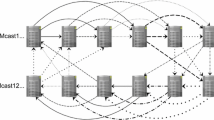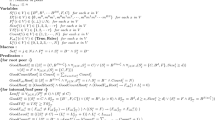Abstract
Group communications, so-called multicast communications, have been introduced as early as 1986 as an efficient way to distribute on a large-scale basis data packets on the whole Internet. With the emergence of new applications driven by the increase of bandwidth in the networks (such as grid computing, large database replication, etc.), reliable multicast is foreseen to be one of the most challenging technologies of the next generation Internet. However, group communications are much more complex than point-to-point communications and solutions that have been implemented and deployed in the unicast world for ensuring reliability can not be so simply applied to the multicast area. Recently, a new paradigm proposes to dynamically add additional functionalities into the routers, thus enabling a whole new range of distributed control mechanisms as opposed to the traditional end-to-end form of control. In this paper, we summarize the various active networking and router-assisted solutions for reliable multicast to avoid or limit the scalability problems of end-to-end approaches for loss recovery, congestion control and heterogeneity support. Then, with the hypothesis that active networking could be deployed on a large scale, we present how this technology could solve the remaining bottlenecks of multicast on wide-area networks.
Résumé
Les communications de groupe, communément appelées communications par diffusion sélective (multicast), ont été introduites dès 1986 comme un moyen efficace pour distribuer à grande échelle des paquets sur l’Internet. L’augmentation de la bande passante dans les réseaux favorisant l’arrivée de nouvelles applications (telles que les grilles de calcul, la replication de grandes bases de données, etc.), la diffusion sélective fiable est un des défis les plus importants de l’Internet de nouvelle génération. Cependant, les communications de groupe sont beaucoup plus complexes que les communications point-à-point (unicast) et les solutions qui ont été implémentées et déployées dans le monde du point à point pour garantir la fiabilité ne peuvent pas être simplement reprises. Récemment, un nouveau paradigme qui propose d’ajouter dynamiquement des fonctionnalités dans les routeurs permet d’envisager toute une nouvelle famille d’algorithmes de commande distribuée par opposition avec les commandes de bout-en-bout plus traditionnelles. L’article présente les différentes solutions de diffusion sélective fiable se basant sur les réseaux actifs, ou à assistance par routeurs, pour limiter les problèmes d’extensibilité des approches traditionnelles de bout-en-bout en ce qui concerne la récupération après perte, la régulation de la congestion et la prise en compte de l’hétérogénéité. Ensuite, en prenant l’hypothèse que les réseaux actifs puissent être déployés à grande échelle, nous présentons comment cette technologie pourrait résoudre les points critiques qui restent pour fournir un support à la diffusion sélective dans un réseau de grande dimension.
Similar content being viewed by others
References
Bush (S. F.),Kulkarni (A.), “Active Networks and Active Network Management: A Proactive Management Framework”,Kluwer Academic/Plenum Publishers, 2001, 196 pp.,isbn 0-306-46560-4.
Byers (J.) et al., “flid-dl: congestion control for layered multicast”,ieee j-sac, Special Issue on Network Support for Multicast Communication, 20(8), October 2002.
Calderon (M.),Sedano (M.),Azcorra (A.),Alonso (C), “Active networks support for multicast applications”,ieee Networks, May/June 1998.
Chayat (R.),Rom (R.), “Applying Deterministic Feedback Suppression to Reliable Multicasting Protocols”,10th ieee International Conference on Computer Communications and Networks (icccn’01).
Chiu (D. M.),Kadansky (M.),Provino (J.), “A congestion control algorithm for tree-based reliable multicast protocols”,ieee infocom 2002.
Chiu (D. M.),Hurst (S.),Kadansky (M.),Wesley (J.), “Tram: A tree-based reliable multicast protocol”,Technical Report tr-98-66,sun Microsystem, July 1998.
Delucia (D.),Obraczka (K.), “Multicast feedback suppression using representatives”,ieee infocom 1997.
Deering (S. E.),Cheriton (D. R.), “Multicast Routing in Datagram Internetworks and Extendedlans”,acm sigcomm ’88 &acmTransactions on Computer Systems,8,No. 2.
Donahoo (M. J.),Ainapure (S. R.), “Scalable multicast representative member selection”,ieee infocom 2001.
Faber (T.), “acc: Using Active Networking to Enhance Feedback Congestion Control Mechanisms”,ieee Network (Special Issue on Active and Programmable Networks), May/June 1998.
Floyd (S.),Handley (M.),Padhye (J.),Widmer (J.), “Equation-based congestion control for unicast applications”,acm sigcomm 2000.
Floyd (S.),Henderson (T.), “The NewReno modification totcp’s fast recovery algorithm”,ietf rfc 2582, 1999.
Floyd (S.),Jacobson (V.),Liu (C.),Mccanne (S.),Zhang (L.), “A reliable multicast framework for lightweight sessions and application level framing”,ieee/acm Transactions on Networking, 5(6), 1997.
Gemmell (J.)et al., “Thepgm Reliable Multicast Protocol”,ieee Networks, special issue on “Multicasting: An Enabling Technology”, January 2003. Also inSpeakman (T.)et al., “pgm reliable transport protocol specification”,ietf rfc 3208.
Holbrook (H.),Singhal (S.),Cheriton (D.), “Log-based receiver-reliable multicast for distributed interactive simulation”,acm sigcomm ’95.
Jacobson (V.), “Congestion avoidance and control”,acm sigcomm ’88.
Jiang (T.),Ammar (M.),Zegura (E.), “Inter-receiver fairness: A novel performance measure for multicast ABR sessions”,Measurement and Modeling of Computer Systems, pages 202–211, June 1998.
Kasera (S.),Bhattacharya (S.), “Scalabe fair reliable multicast using active services”,ieee Network, Special issue on Multicast, 2000.
Lee (E.), “A Survey on Congestion Control for Reliable Multicast”, www.cs.uh.edu/~ejlee/6360.pdf
Lehman (L.),Garland (S.),Tennehouse (D.), “Active reliable multicast”,ieee infocom 1998.
Levine (B. N.),Garcia-Luna-Aceves (J. J.), “Improving internet multicast with routing labels”,ieee International Conference on Network Protocols (ICNP’97).
Macedonia (M. R.),Brutzman (D. P.), “MBone Provides Audio and Video Across the Internet”,ieee Computer,27(4), April 1994.
Maimour (M.),Pham (C.), “Dealing with heterogeneity in a fully reliable multicast protocol”,ieee International Conference On Networks (icon2003).
Maimour (M.),Pham (C.), “amca: an active-based multicast congestion avoidance algorithm”,8th ieee Symposium on Computers and Communications (iscc2003).
Maimour (M.),Pham (C.), “Dynamic replier active reliable multicast (dyram)”.7th ieee Symposium on Computers and Communications (iscc2002).
Maimour (M.),Mazuy (J.),Pham (C.), “The cost of active services in active reliable multicast”,4th ieee Annual International Workshop on Active Middleware Services (ams2002).
Metzler (B.)et al., “AMnet: Heterogeneous Multicast Services based on Active Networking”,ieeeOpenArch’99.
Papadopoulos (C.),Parulkar (G. M.),Varghese (G.), “An error control scheme for large-scale multicast applications”,ieee infocom 1998.
Paul (S.),Sabnani (K.), “Reliable multicast transport protocol (rmtp)”,ieee jsac, Special issue on Network Support for Multipoint Communications,15(3), April 1997.
Rhee (I.),Ballaguru (N.),Rouskas (G. N.), “mtcp : Scalable tcp-like congestion control for reliable multicast”,ieee infocom 1999.
Rizzo (L.), “pgmcc: atcp-friendly single-rate multicast”,acm sigcomm 2000.
Tennenhouse (D. L.),Smith (J.),Sincoskie (D.),Wetherall (D.),Minden (G.), “A survey of active network research”,ieee Communications Magazine,35(1), pp. 80–86, January 1997.
Vicisano (L.),Rizzo (L.),Crowcroft (J.), “tcp-like Congestion Control for Layered Multicast Data Transfer”,ieee infocom 1998.
Wang (H. A.),Schwartz (M.), “Achieving bounded fairness for multicast andtcp traffic in the internet”,acm sigcomm 1998.
Yamamoto (L.),Leduc (G.), “An active layered multicast adaptation protocol”,ieee iwan 2000.
Yang (R.),Lam (S.), “Internet Multicast Congestion Control: A Survey.ieee ict 2000.
Yavatkar (R.),Griffoen (J.),Sudan (M.), “A reliable dissemination protocol for interactive collaborative applications”,acm Multimedia, 1995.
Zabele (S.)et al., “Improving Distributed Simulation Performance Using Active Networks”,World Multi Conference 2000.
Rudenko (A.),Reiher (P.), “Adaptation Planning for Unicast Connections in Active Networks”,ieee iwan 2003.
Suzuki (T.),Denazis (S.),Cheng (L.),Becker (T.),Gabrijelcic (D.),Lazanakis (A.), “Dynamic Deployment & Configuration of Differentiated Services Using Active Networks”,ieee iwan 2003.
Author information
Authors and Affiliations
Rights and permissions
About this article
Cite this article
Maimour-Bouyoucef, M., Pham, C. A survey of active and router-assisted reliable multicast solutions. Ann. Télécommun. 59, 543–564 (2004). https://doi.org/10.1007/BF03179687
Received:
Accepted:
Issue Date:
DOI: https://doi.org/10.1007/BF03179687
Key words
- Multicast
- State of the art
- Internet
- Point to multipoint communication
- Reliability
- Active telecommunication network
- Congestion control
- arq
- Heterogeneity




